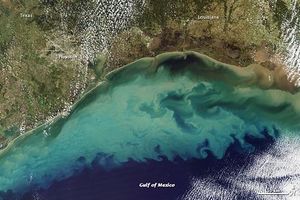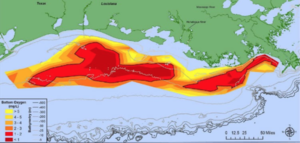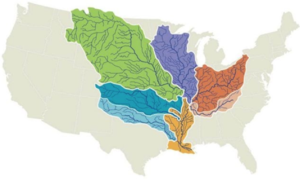Mississippi Dead Zone: Difference between revisions
(Created page with "==Overview== Image:Gulfofmexico.jpg|thumb|300px|right|Electron micrograph of the Ebola Zaire virus. This was the first photo ever taken of the virus, on 10/13/1976. By Dr....") |
|||
| Line 1: | Line 1: | ||
==Overview== | ==Overview== | ||
[[Image:Gulfofmexico.jpg|thumb|300px|right| | [[Image:Gulfofmexico.jpg|thumb|300px|right|Image of the Dead Zone in the Northern Gulf of Mexico<ref>[Bruckner, M. (2019, October 15). The Gulf of Mexico Dead Zone. Retrieved June 02, 2020, from https://serc.carleton.edu/microbelife/topics/deadzone/index.html]</ref>]] | ||
<br>By Kelly Poulos<br> | <br>By Kelly Poulos<br> | ||
The Gulf of Mexico dead zone is an area of oxygen-depleted waters at the outflow of the Mississippi River. In the case of the Gulf of Mexico, the dead zone is defined as being the portion of the water column with a dissolved oxygen concentration less than 2 milligrams per liter.<ref>[Ritzel, B. Gulf of Mexico’s Hypoxic Dead Zone.]</ref>[[Image:GOMoxygen.png|thumb|300px|right|Bottom Oxygen Concentration in the Gulf of Mexico<ref>[Large 'dead zone' measured in Gulf of Mexico. (n.d.). Retrieved June 02, 2020, from https://www.noaa.gov/media-release/large-dead-zone-measured-in-gulf-of-mexico]</ref>]] The record size of this hypoxic area is 8,776 square miles and it is caused largely by excess nutrient pollution into the Mississippi River.<ref>[NOAA forecasts very large 'dead zone' for Gulf of Mexico. (n.d.). Retrieved June 02, 2020, from https://www.noaa.gov/media-release/noaa-forecasts-very-large-dead-zone-for-gulf-of-mexico]</ref> | |||
[[Image:Watershed.png|thumb|300px|right|Size of Mississippi River Watershed Feeding into the Gulf of Mexico<ref>[Gulf of Mexico Dead Zone. (n.d.). Retrieved June 02, 2020, from https://www.nature.org/en-us/about-us/where-we-work/priority-landscapes/gulf-of-mexico/stories-in-the-gulf-of-mexico/gulf-of-mexico-dead-zone/]</ref>]] The excess of nutrients, largely nitrogen and phosphorus from runoff fertilizers and treated sewage discharge from urban areas, encourages the growth of algae and development of algal blooms. When these algae die, they become a food source for bacteria, which consume dissolved oxygen as they decompose the algae, resulting in areas of the ocean with oxygen levels that are insufficient to support aquatic life, especially when there is strong stratification that prevents reoxygenation of the water column. As a result of this hypoxia, the microbial community in the water column shifts dramatically. This hypoxic zone can cover anywhere from 20%-50% of the Gulf of Mexico water column during the summer months and can persist through September.<ref>[Tsementzi, D., Wu, J., Deutsch, S., Nath, S., Rodriguez-R, L. M., Burns, A. S., ... & Stone, B. K. (2016). SAR11 bacteria linked to ocean anoxia and nitrogen loss. Nature, 536(7615), 179-183.]</ref> | |||
The Gulf of Mexico dead zone is an area of oxygen-depleted waters at the outflow of the Mississippi River. In the case of the Gulf of Mexico, the dead zone is defined as being the portion of the water column with a dissolved oxygen concentration less than 2 milligrams per liter.<ref>[ | |||
<br><br>A citation code consists of a hyperlinked reference within "ref" begin and end codes. | <br><br>A citation code consists of a hyperlinked reference within "ref" begin and end codes. | ||
Revision as of 15:19, 2 June 2020
Overview

By Kelly Poulos
The Gulf of Mexico dead zone is an area of oxygen-depleted waters at the outflow of the Mississippi River. In the case of the Gulf of Mexico, the dead zone is defined as being the portion of the water column with a dissolved oxygen concentration less than 2 milligrams per liter.[2]

The record size of this hypoxic area is 8,776 square miles and it is caused largely by excess nutrient pollution into the Mississippi River.[4]

The excess of nutrients, largely nitrogen and phosphorus from runoff fertilizers and treated sewage discharge from urban areas, encourages the growth of algae and development of algal blooms. When these algae die, they become a food source for bacteria, which consume dissolved oxygen as they decompose the algae, resulting in areas of the ocean with oxygen levels that are insufficient to support aquatic life, especially when there is strong stratification that prevents reoxygenation of the water column. As a result of this hypoxia, the microbial community in the water column shifts dramatically. This hypoxic zone can cover anywhere from 20%-50% of the Gulf of Mexico water column during the summer months and can persist through September.[6]
A citation code consists of a hyperlinked reference within "ref" begin and end codes.
To repeat the citation for other statements, the reference needs to have a names: "<ref name=aa>”
The repeated citation works like this, with a back slash.[7]
- ↑ [Bruckner, M. (2019, October 15). The Gulf of Mexico Dead Zone. Retrieved June 02, 2020, from https://serc.carleton.edu/microbelife/topics/deadzone/index.html]
- ↑ [Ritzel, B. Gulf of Mexico’s Hypoxic Dead Zone.]
- ↑ [Large 'dead zone' measured in Gulf of Mexico. (n.d.). Retrieved June 02, 2020, from https://www.noaa.gov/media-release/large-dead-zone-measured-in-gulf-of-mexico]
- ↑ [NOAA forecasts very large 'dead zone' for Gulf of Mexico. (n.d.). Retrieved June 02, 2020, from https://www.noaa.gov/media-release/noaa-forecasts-very-large-dead-zone-for-gulf-of-mexico]
- ↑ [Gulf of Mexico Dead Zone. (n.d.). Retrieved June 02, 2020, from https://www.nature.org/en-us/about-us/where-we-work/priority-landscapes/gulf-of-mexico/stories-in-the-gulf-of-mexico/gulf-of-mexico-dead-zone/]
- ↑ [Tsementzi, D., Wu, J., Deutsch, S., Nath, S., Rodriguez-R, L. M., Burns, A. S., ... & Stone, B. K. (2016). SAR11 bacteria linked to ocean anoxia and nitrogen loss. Nature, 536(7615), 179-183.]
- ↑ Cite error: Invalid
<ref>tag; no text was provided for refs namedaa
